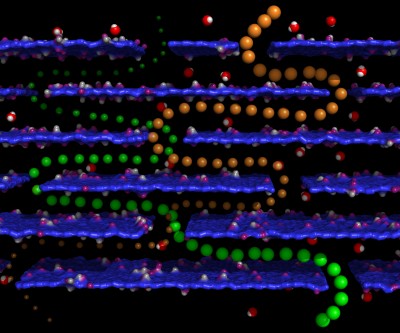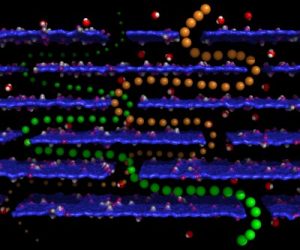
Researchers from the Monash Centre for Atomically Thin Materials (MCATM) at Monash University have developed a new, inexpensive and reliable method for studying the way ions move through tiny, nanosized channels.

Image credit: http://monash.edu/news/show/simple-graphene-cascade-allows-unprecedented-insights-into-nanoionics
Previously, studying the phenomenon of nanoscale ionic transport was only possible by cutting nano channels in a process known as photolithography, which is a costly, relatively inefficient and limited method.
Dr Chi Cheng, a postdoctoral researcher from MCATM and the first author of the research, said the team was able to develop a simple, inexpensive and easily scalable graphene-based technique to make nanochannels using a process similar to paper-making.
”The work demonstrates an unconventional way to use graphene to make nanofluidic devices, a novel research tool tuneable at length scale ranges that cannot be achieved with any other material,” Dr Cheng said.
“With this, we are able to unveil the fundamental, yet unusual ion transport behaviours as a function of channel size across the entire sub-10 nm length scales.”
By stacking multiple layers of graphene sheets, Dr Cheng and his fellow researchers were able to create a macroscopic membrane material, which houses a series of cascading nanoslits. Ions are forced to travel through the mazy minute openings in the membrane, allowing the researchers to begin to understand the movement of ions under a restriction level below 10 nanometres.
Dr Cheng said that the interlayer spacing can be readily adjusted through manipulating the weak interactions among neighbouring graphene layers. Counterintuitively, ions have been seen moving at much higher rates as the spacing decreases, speeding through the tortuous paths between graphene layers under electric potential.
Research supervisor Dr Jefferson Zhe Liu said the study reveals an anomalous scaling relation for ion transport in the unique cascading nanoslit system enclosed in graphene membranes.
“A combination of tuneable graphene membranes in experiments and computer simulations allow us to obtain a statistically representative microstructure model of the unique cascading nanoslits in graphene membranes, which was not attainable in previous studies,” Dr Liu said.
Research lead and Director of MCATM, Professor Dan Li, said he was excited about the potential impact of this development.
“Nano-confined ion transport, or nanoionics, is crucial to new technologies related to energy, water, and biomedicine. It has been challenging to quantitatively study nanoionics because of the lack of nanoionic materials with the feature size tuneable across the critical nanometre scale,” Professor Li said.
“The ease of scalable production and excellent structural tuneability makes our graphene membranes promising as an exceptional experimental platform to explore new and exciting nanoionic phenomena. It also makes it very easy to transfer the fundamental discoveries to technological innovations, enabling new generation hi-tech in energy storage and conversion, membrane separation and biomedical devices. This is a very exciting area we plan to pursue in the coming years.”

















